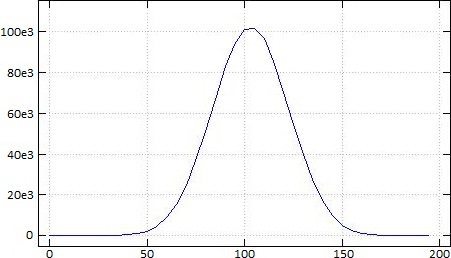15. Central Limit Theorem
An illustration of the central limit theorem, that the sum of independent random variables converges to the normal distribution [51b].
t←¯1+{≢⍵}⌸(⍳41),(5×⍳40)⍸+⌿?10 1e6⍴21
⍴t
41
5 8⍴t
0 0 0 0 0 13 28 90
317 894 2095 4574 8671 15001 24338 36728
51254 66804 82787 93943 101045 101752 96510 85281
70418 54506 39802 27267 16964 9764 5031 2467
1059 422 136 32 6 1 0 0
t counts the number of occurrences in the intervals with endpoints 5×⍳40 , of 1e6 samples from the sum of ten repetitions of ?21 . A plot of t :

The derived function {≢⍵}⌸x counts the number of occurrences of each unique cell of x . On 1-byte integers the computation takes only 1.4 times as long as required for the apparently simpler problem ⌈/x . Thinking about an obvious C implementation for {≢⍵}⌸x leads to a non-obvious implementation for ⌈/x [15a] faster than
max=*x++; for(i=1;i<n;++i){if(max<*x)max=*x; ++x;}